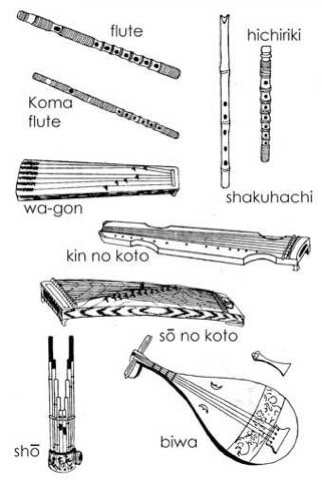music
Murasaki Shikibu herself played the
koto, and it is clear from reading The Tale of Genji that she was knowledgeable about many styles of music. Most of the characters in her tale are accomplished musicians, and Murasaki uses their choice of instrument and level of skill as insights into their personalities. In the chapter entitled "New Herbs, Part Two" several of Prince Genji's women perform an all-female concert for the emperor. The Akashi Lady plays the lute-like biwa, strong and steadfast. Her daughter the Akashi Princess takes the 13-string koto called the sô—a"gentle, feminine sort of instrument, taking its place hesitantly and deferentially among the others." The character Murasaki plays the wa-gon, or "native koto" which is not only difficult, but "everything about it is fluid and indefinite and there are no clear guides." Genji's new bride, the childish Third Princess takes the 7-string kin no koto (This is the Chinese gu ghim that Master Jyo plays in my tale.) In The Tale of Genji, it is such a difficult and subtle instrument that only Prince Genji has true mastery of it. Genji himself realizes that teaching the Third Princess to play it is a hopeless task.
Besides its value for personal enjoyment, music was an essential part of court ritual and public ceremonies. Some notion of its importance is shown by the fact that the Bureau of Music (Gagakuryō) was by far the most important aspect of the Ministry of Civil Affairs in Murasaki's day. This Bureau selected and trained a cadre of singing, dancing, and instrumental music teachers.
This court music of Heian Japan, called gagaku, can still be heard today, amazingly little changed from its 11th-century form. Important Shinto shrines maintain gagaku orchestras, as does the music department of the Imperial Palace in Tokyo. The stylized, heavily costumed dance that sometimes accompanies this music is known as bugaku. The performance of a brief bugaku piece is very popular for modern Shrine weddings.

Listen to the short piece "Banshikichō netori." This is the prelude for the work Seigaiha (Waves of the Blue Ocean), a popular piece mentioned in The Tale of Genji. In the chapter "An Autumn Excursion" Genji himself dances this piece along with his best friend, Tō no Chūjō.